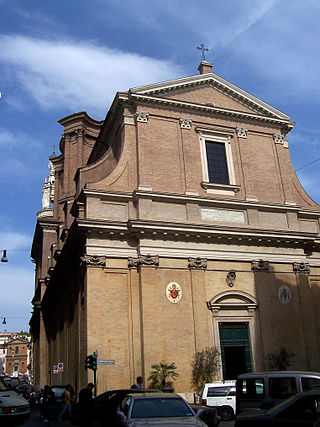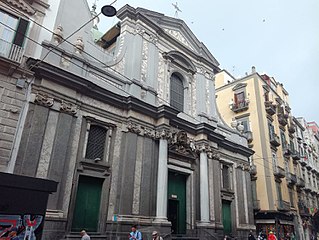
The Church of St. Ignatius of Loyola at Campus Martius is a Roman Catholic titular church, of deaconry rank, dedicated to Ignatius of Loyola, the founder of the Society of Jesus, located in Rome, Italy. Built in Baroque style between 1626 and 1650, the church functioned originally as the chapel of the adjacent Roman College, which moved in 1584 to a new larger building and was renamed the Pontifical Gregorian University.

Sebastiano Conca was an Italian painter.

Sant'Andrea della Valle is a minor basilica in the rione of Sant'Eustachio of the city of Rome, Italy. The basilica is the general seat for the religious order of the Theatines. It is located at Piazza Vidoni, at the intersection of Corso Vittorio Emanuele and Corso Rinascimento.

San Francesco a Ripa is a church in Rome, Italy. It is dedicated to Francis of Assisi who once stayed at the adjacent convent. The term Ripa refers to the nearby riverbank of the Tiber.

Sant'Andrea delle Fratte is a 17th-century basilica church in Rome, Italy, dedicated to St. Andrew. The Cardinal Priest of the Titulus S. Andreae Apostoli de Hortis is Ennio Antonelli.

Santa Maria in Vallicella, also called Chiesa Nuova, is a church in Rome, Italy, which today faces onto the main thoroughfare of the Corso Vittorio Emanuele and the corner of Via della Chiesa Nuova. It is the principal church of the Oratorians, a religious congregation of secular priests, founded by St Philip Neri in 1561 at a time in the 16th century when the Counter Reformation saw the emergence of a number of new religious organisations such as the Society of Jesus (Jesuits), the Theatines and the Barnabites.

Santa Maria in Campitelli or Santa Maria in Portico is a church dedicated to the Virgin Mary on the narrow Piazza di Campitelli in Rione Sant'Angelo, Rome, Italy. The church is served by the Clerics Regular of the Mother of God.

The Basilica of Saint Nicholas of Tolentino is a Roman Catholic church and minor basilica that is part of the Augustinian monastery in the hill-town of Tolentino, province of Macerata, Marche, central Italy. The church is a former cathedral of the Roman Catholic Diocese of Tolentino, suppressed in 1586.

The Spanish National Church of Santiago and Montserrat, known as Church of Holy Mary in Monserrat of the Spaniards is a Roman Catholic titulus church and National Church in Rome of Spain, dedicated to the Virgin of Montserrat. It is located in the Rione Regola, at the intersection of alleyway of Via della Barchetta and the narrow Via di Monserrato, with the facade on the latter street, about three blocks northwest of the Palazzo Farnese.

Giovanni Giacomo Barbelli was an Italian painter of the Baroque period, active in Lombardy. He was a canvas and fresco painter known for his religious and mythological scenes that decorate many churches and residences in Lombardy. He was a highly skilled draughtsman and a brilliant colorist. His work shows an inventive imagination and a thorough knowledge of perspective.

San Giovanni Evangelista is a church in Parma, northern Italy, part of a complex also including a Benedictine convent and the San Giovanni Old pharmacy.

The church of St. Nicholas the Charitable is a church located on via Toledo, almost midway between Piazza Carità and Piazza Dante in Naples, Italy.

The church of Santa Maria delle Grazie in Brescia is located on at the west end of Via Elia Capriolo, where it intersects with the Via delle Grazie. Built in the 16th century and remodeled in the 17th century, it still retains much of its artwork by major regional artists, including one of its three canvases by Moretto. The other two are now held at the Pinacoteca Tosio Martinengo. The interior is richly decorated in Baroque fashion. Adjacent to the church is the Sanctuary of Santa Maria delle Grazie, a neo-gothic work.

San Paolo in Campo Marzio is a Roman Catholic church in Verona, region of Veneto, Italy.

Fossombrone Cathedral is a Roman Catholic cathedral dedicated to Saint Aldebrandus and Saint Augustine located in the Piazza Mazzini at the end of Corso Garibaldi in the center of the town of Fossombrone in the province of Pesaro and Urbino in the region of Marche, Italy. Formerly the cathedral of the Diocese of Fossombrone, since 1986 it has been a co-cathedral of the Diocese of Fano-Fossombrone-Cagli-Pergola.
Santa Maria in Via is a Baroque style Roman Catholic church and Marian Shrine in Camerino, in the province of Macerata, region of Marche, Italy.

The Church of Saint Ignatius is a Baroque church of Palermo. It is located in the ancient neighborhood of the Olivella, in the quarter of the Loggia, within the historic centre of Palermo.

The Church of Saint Teresa is a Baroque Roman Catholic church, located on Piazza della Kalsa, facing the Porta de Greci in the ancient quarter of the Kalsa of the city of Palermo, region of Sicily, Italy.

San Francesco Borgia is a Roman Catholic church located on Via Crociferi #7, adjacent to the former Collegio Gesuita, and parallel to San Benedetto, and about a block south on Crociferi of the church and convent of San Giuliano, in the city of Catania, region of Sicily, southern Italy. The church is mainly used for exhibits, but still holds much of the original Jesuit artwork.

The church of San Francesco of Assisi is a Catholic religious building in Pavia, Lombardy, Italy.




















